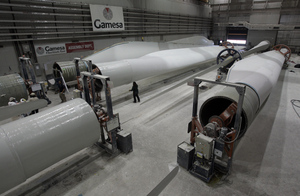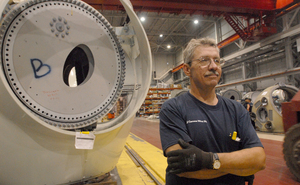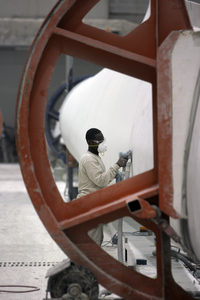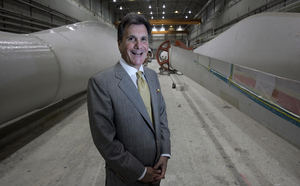Posted on Sun, Jul. 20, 2008
Wind sails into the Pa. power scene
By Sandy Bauers
Inquirer Staff Writer
LAURENCE KESTERSON / Inquirer Staff Photographer
Some large wind instruments take shape at Gamesa Technology Corp. in Fairless Hills. Every turbine built there through at least 2010 - about 500 a year - is already sold. As energy prices rise, demand for the wind's free, renewable power is breezing up.
APRIL SAUL / Inquirer Staff Photographer
Losing his steelworker's job was a blow to Jim Bauer, but today he works building wind turbines for Gamesa Technology. His old plant is a key player in Pennsylvania's transformation from rust to green.
The Gamesa plant runs 24 hours a day, six days a week. Its 600 employees, many former steelworkers, staff three shifts.
Julius Steiner, Gamesa USA's CEO, wants to expand in Pa. CEO, wants to expand in Pa.
The year Jim Bauer was born - 1952 - a massive steel mill was rising atop a former asparagus farm in Lower Bucks County.
Bauer would spend most of his working life in U.S. Steel's Fairless Works - until he was forced to retire in 2002, marking the end of an era.
Now, it's the beginning of another, and Bauer, 56, is part of that, too.
It's about wind.
Every morning at 6, Bauer is back at work in one of the old U.S. Steel buildings, heading a team that makes giant hubs for wind turbines.
Gamesa Technology Corp. Inc., part of a Spanish company that's one of the world's largest turbine makers, took over part of the property - now the Keystone Industrial Port Complex - in 2006 and is a key player in its transformation from rust to green.
Across the state, wind has become the dominant renewable-energy fuel.
Nine commercial wind farms with a total of 175 turbines have a capacity of 294 megawatts - enough to power 78,000 households. Five more wind farms under construction will double that by year's end.
About 70 more projects are in development.
"Right now, it's the cheapest renewable resource available," said Charlie Young, a spokesman for the state Department of Environmental Protection. "It's on par, in some cases, with traditional sources of energy."
Indeed, as those fuels rise in price, wind remains free.
Once a plant is built, "you know what its costs are going to be for 25 years," said Tom Tuffey, energy expert for the advocacy group PennFutures.
Nationwide, wind provides just 1.2 percent of electricity needs, but that's changing.
Last year, with $9 billion worth of new projects, U.S. wind power capacity increased 46 percent. Wind accounted for about a third of all new electric generation.
The projects were enough to power 1.5 million homes.
The national wind market is now the fastest-growing in the world.
The federal Department of Energy recently brokered a research collaboration between Gamesa and five other turbine makers aimed at getting 20 percent of the country's electricity needs from wind by 2030.
This month, Texas oil tycoon T. Boone Pickens introduced a plan to get there in 10 years.
Also in Texas, the biggest state for oil and wind, officials have announced the biggest investment in wind energy in U.S. history. Billions of dollars will build transmission lines from windy west Texas to needy urban areas.
Although Pennsylvania's winds hardly rank with those of the Great Plains states - the "Saudi Arabia of wind" - the state still has enough to power five million homes, Gov. Rendell has said.
Pennsylvania has "a whole host of advantages when it comes to developing and operating wind farms," said Paul Copleman, spokesman for Iberdrola Renewables, another Spanish company, which has an East Coast base in Radnor and operates wind farms.
(Last month, Iberdrola and Gamesa signed what they called the world's largest turbine contract, representing a capacity of 4,500 megawatts. The turbines will go to Spain, Europe, Mexico and the United States.)
Pennsylvania's Appalachian ridges - places with names like Wind Gap - have consistent winds and access to transmission lines, Copleman said. "A lot of places have one but not the other."
Last year, the state ranked 10th in new installations and 14th in total wind power.
One impetus is a requirement that 18 percent of the state's energy come from alternative and renewable sources by 2020.
Proponents tout wind as pollution-free electricity.
It's also seen as an economic boon for rural areas and - like Lower Bucks - former industrial centers.
In April, ground was broken at a former Cambria County strip mine where 25 turbines will be installed.
The transition from coal to wind is a sign of the times, state officials said.
New Jersey has focused more on solar power. Wind maps show its biggest winds are offshore, where it's more expensive to build.
Its one big project is a five-turbine, 7.5-megawatt installation inland from Atlantic City.
However, the state Board of Public Utilities, with $19 million in grant money, is evaluating five proposals for an offshore wind pilot project. A decision is expected in August.
Wind still has detractors.
Some conservationists don't want to see turbines atop scenic mountain ridges.
Wildlife advocates have not made peace with wind, either, even though they acknowledge pollution from fossil-fuel plants could kill more birds than the blades of the turbines.
The blades now turn more slowly to reduce what some term the "Cuisinart effect," but so many turbines are going up "that we don't know what the impacts to birds will be," said Michael Fry, an ornithologist with the American Bird Conservancy.
He said one wind farm in Spain had installed radar so the turbines could be shut down when migrating raptors were headed in.
In north-central Pennsylvania, astronomers who congregate at Cherry Springs State Park have additional worries.
One of the darkest places in the East, it is the state's designated "dark sky park."
A wind farm is being built about 11 miles away. Others have been proposed.
Yardley's Ed Murray, past president of the Bucks-Mont Astronomical Association Inc., is worried about aircraft warning lights atop the towers. Worse, with the wind farms may come streetlights, traffic and development.
"Once you start down this road, it's going to be harder and harder to control the problem of light pollution," he said.
Cherry Springs Dark Sky Fund director Maxine Harrison said she remained hopeful but was afraid that concerns would be overwhelmed by the "ooh-ah factor" of wind.
Or, perhaps, its momentum.
The $34 million Gamesa plant in Bucks County - another is in Western Pennsylvania - is running 24 hours a day, six days a week.
Its 600 employees, many former steelworkers still represented by their old union, staff three shifts.
Every turbine they build at least through 2010 - about 500 a year - is sold.
Wind turbines have become bigger and more powerful. Gamesa's two-megawatt behemoths can each power more than 500 homes.
A tower and its blades top out at 404 feet, 26 feet higher than the towers of the Walt Whitman Bridge.
The main obstacle to growth is the supply of components - 8,000 per turbine, most of them made overseas, said Gamesa USA's chief executive officer, Julius Steiner. Ball bearings come from China, gearboxes from Spain.
Steiner wants to build supply-chain clusters around the plant. "If that happens, you're talking about a lot of jobs."
It could employ others like Jim Bauer, who worked at U.S. Steel for more than two decades and loved it.
When forced into early retirement, he attended computer school.
One day, he saw a help-wanted ad that offered travel abroad and a high-paying job in a new venture. He thought it was a hoax.
It wasn't. In March 2006, Gamesa sent Bauer to Spain for three months of training.
For him, the pay isn't as good. At U.S. Steel, he said, he could make more than $70,000, counting incentives and forced overtime.
At Gamesa, it's more like $40,000. But he has his pension. And, truth is, he loves it.
"I'm proud," Bauer said. "We need to find a way to produce electricity without emissions. I think about that all the time."
U.S. Steel still has 90 employees in a nearby building. They galvanize steel, coating it with zinc to prevent rust.
But it's all that remains of the giant plant that, at its height in 1974, employed 8,000, the company said.
Oddly enough, Bauer now works about 1,000 yards away from his old building.
A few weeks ago, they tore it down. Bauer took photos.
Then he went back to work.
Contact staff writer Sandy Bauers at 215-854-5147 or [email protected].
-
 Bulletin Board
Quick Nav
Bulletin Board
Quick Nav

- Bulletin Board
- Discussion Board
- WaccoReader
- GOOD NEWS: Wind sails into the Pa. power scene
Click Banner For More Info
See All Sponsors
Advertise Here
So Long and Thanks for All the Fish!
This site is now closed permanently to new posts.We recommend you use the new Townsy Cafe!
Click anywhere but the link to dismiss overlay!
Results 1 to 1 of 1
- Share this thread on:
- Follow: No Email
-
Thread Tools
-
Search Thread
-
Zeno Swijtink

-
Real Name: (not displayed to guest users)
-
Join Date: Jul 19, 2005
-
Location: Sebastopol
- Expressed Gratitude: 50
- Received Gratitude 442 times for 202 posts
-
Last Online 02-10-2024
- View Profile
-
 Ignore
Ignore
- Visit Homepage
-
 View Posts: (3,221)
View Posts: (3,221)
GOOD NEWS: Wind sails into the Pa. power scene
-
Quick Navigation
WaccoReader
Top
- Site Areas
- Settings
- Private Messages
- Subscriptions
- Who's Online
- Search Categories
- Categories Home
- Categories
- Sonoma County Bulletin Board
- General Community
- Coronavirus
- Coronavirus Conspiracy Theories
- Events, Classes and Meetings
- Business Directory
- Sales & Timely Offers
- Services/Referrals Wanted
- Health & Wellness
- For Sale/Free/Wanted
- Employment Offered & Wanted
- Housing/Offices
- WaccoElders
- Housesitting/Petsitting
- Pets and other Critters
- Marin County Bulletin Board
- Discussion Board
- About WaccoBB
« (Previous Thread)
GOOD NEWS: Green Becomes Official Color of Baseball
Psych nurse has affair with patient, he sues.... (Next Thread) »
Psych nurse has affair with patient, he sues.... (Next Thread) »
Similar Threads
-
MORE GOOD NEWS: Experimental plant turns poop to power
By Zeno Swijtink in forum WaccoReaderReplies: 3Last Post: 07-12-2008, 11:02 AM -
GOOD NEWS: Electrostatic Wind Energy Converter
By Zeno Swijtink in forum WaccoReaderReplies: 0Last Post: 07-04-2008, 01:56 PM -
GOOD NEWS: Cheap carbon trap cleans up power station emissions
By Zeno Swijtink in forum WaccoReaderReplies: 0Last Post: 05-24-2008, 02:19 PM -
Good News
By MsTerry in forum WaccoTalkReplies: 3Last Post: 04-15-2008, 08:56 AM -
Anti -wind power legislation
By phooph in forum WaccoReaderReplies: 0Last Post: 02-25-2006, 01:52 PM
Bookmarks
-
 Facebook
Facebook
-
 Twitter
Twitter
-
 StumbleUpon
StumbleUpon







